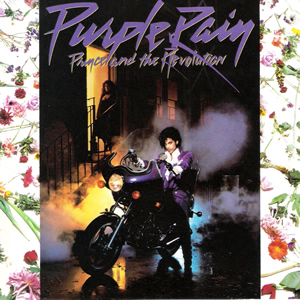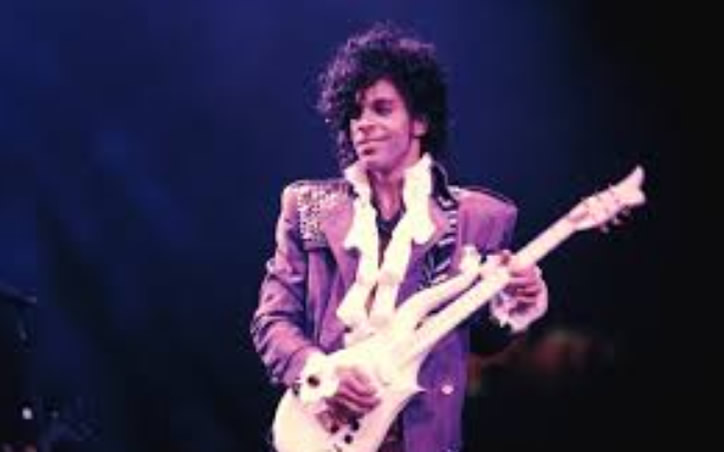Purple Rain by Prince
 Prince reached the pinnacle of his success in 1984, with the release of the musically potent Purple Rain to accompany the major motion picture of the same name. The sixth studio album by the Minneapolis-based recording artist, it marks a slight departure from his earlier solo work. For the first time, Prince added and fully credited his band, The Revolution, and the production emphasized full band performances and multiple, layered instruments. The resulting hybrid of funk, rock, R&B and synthesized dance beats became one of the most popular and well regarded albums of the 1980s, reaching the top of the charts and selling over 20 million copies worldwide.
Prince reached the pinnacle of his success in 1984, with the release of the musically potent Purple Rain to accompany the major motion picture of the same name. The sixth studio album by the Minneapolis-based recording artist, it marks a slight departure from his earlier solo work. For the first time, Prince added and fully credited his band, The Revolution, and the production emphasized full band performances and multiple, layered instruments. The resulting hybrid of funk, rock, R&B and synthesized dance beats became one of the most popular and well regarded albums of the 1980s, reaching the top of the charts and selling over 20 million copies worldwide.
Keyboardist Lisa Coleman was one of only two additional musicians (along with guitarist Dez Dickerson) to perform on Prince’s breakthrough double album 1999. Following the tour for that album, Dickerson left the group for “religious reasons” and was replaced by guitarist and vocalist Wendy Melvoin, a childhood friend of Coleman. As mainstream success began to grow for Prince, due in part to the proliferation of MTV, he decided to use his band less sparsely and load up for an ambitious follow-up. Filmed almost entirely in Minneapolis, the movie Purple Rain contains stories behind many of the soundtrack’s songs and uses many musicians from the local scene.
As was the case on all but his earliest albums, Prince composed and arranged all of the songs on this album. However, he did elicit some input from his new band members. Another unique attribute of Purple Rain is the fact that three songs on the album were actually recorded live at the First Avenue Club in Minneapolis with Prince adding some studio touches and edits to these later. The August 1983 show was a benefit concert and is historic as the first live appearance by Melvoin with The Revolution.
 Purple Rain by Prince |
|
|---|---|
| Released: June 25, 1984 (Warner Brothers) Produced by: Prince & the Revolution Recorded: First Avenue & The Warehouse, Minneapolis and The Record Plant & Sunset Sound, Los Angeles, August 1983–March 1984 |
|
| Side One | Side Two |
| Let’s Go Crazy Take Me with U The Beautiful Ones Computer Blue Darling Nikki |
When Doves Cry I Would Die 4 U Baby I’m a Star Purple Rain |
| Primary Musicians | |
| Prince – Lead Vocals, Guitar, Bass, Keyboards Wendy Melvoin – Guitars, Vocals Lisa Coleman – Keyboards, Vocals Matt Fink – Keyboards Bobby Z – Drums, Percussion |
|
Generally regarded as the most pop-oriented of Prince’s career, Purple Rain begins the story with Prince narrating along to a church-like organ, speaking about enjoying the here and now on the opener “Let’s Go Crazy”. An electronic drum beat kicks in along with a bouncy organ riff, and it drives this song into a frenzy of wild guitars and intense vocals, until it crashes into a cacophony of whining guitars and screaming. The song was one of two on this album to top the charts.
“Take Me With You” is a duet with Apollonia, who also starred as Prince’s romantic counterpart in the film. The song was originally meant to be on her Apollonia 6 album, but its inclusion on Purple Rain necessitated cuts to the suite-like following song, “Computer Blue”. This latter song melds synthesizers and a quirky, sloshy electronic beat with some guitar elements and perhaps stands out as the most stereotypically “eighties” in sound and style. “Darling Nikki” caused quite a stir with Tipper Gore and the Parents Music Resource Center for the racy subject matter addressed in the lyrics. The song itself is sparsely arranged with the emphasis on Prince’s chanted and groaned vocals. The song was not the centerpiece of the album, but it probably helped boost the notoriety of the album with all of the media attention surrounding the risqué lyrics.
“When Doves Cry” is one of the most creative songs on the album. Again, the arrangement is sparse as there is no bass, just an electronic drum beat, synthesized melodic sounds and Prince’s emotive vocals. The layers of sound are subtle and create a smokey, almost psychedelic feel. Written specifically for a sequence in the film, this worldwide hit was the top selling single for the year 1984, according to Billboard magazine.

The album’s final three tracks were all recorded live in 1983. “I Would Die 4U” is a departure from the rest of the album and is almost anthemic with a repetitive beat, chanted refrain and synthesized sounds. The song fades abruptly into “Baby I’m a Star”, delivered almost like a show tune with theatrical lyrics and a pounding steady, dance beat. Prince’s masterpiece on this album is the closing title track, “Purple Rain”. This song is Prince reaching into his blues and funk influences and coming up with a depth of sound in many layers. The guitars are front and center in this song with the solo soaring above the strings and drums, closing the album on a very high note.
Purple Rain was added to the Library of Congress’s National Recording Registry list of sound recordings that “are culturally, historically, or aesthetically important”. Prince also won two Grammy Awards in 1985 for the album. However, he also announced that year that he would stop touring and making music videos after the release of his next album, Around the World in a Day, which ultimately led to the disbandment of the short-lived “Revolution”.
~
Part of Classic Rock Review’s celebration of 1984 albums.





March 24, 2019 @ 11:02 pm
I like that you wrote “Whiney guitars”. Cheers man